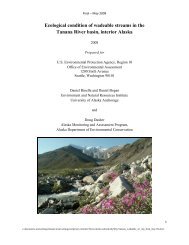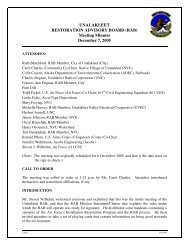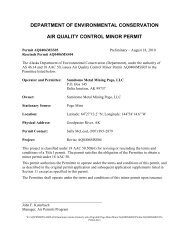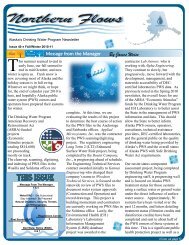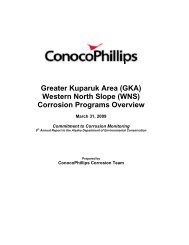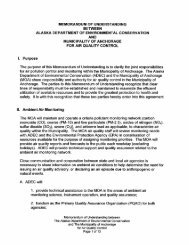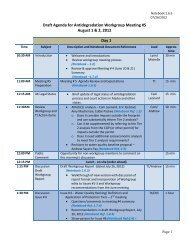2012 Ocean Ranger Guidebook Revision 3-7-12 - Alaska ...
2012 Ocean Ranger Guidebook Revision 3-7-12 - Alaska ...
2012 Ocean Ranger Guidebook Revision 3-7-12 - Alaska ...
You also want an ePaper? Increase the reach of your titles
YUMPU automatically turns print PDFs into web optimized ePapers that Google loves.
<strong>20<strong>12</strong></strong> <strong>Ocean</strong> <strong>Ranger</strong> <strong>Guidebook</strong> 3-7-<strong>12</strong><br />
Incinerator ash is not normally a hazardous waste. Through relatively straightforward<br />
waste management strategies, items that would cause the ash to be hazardous are separated from<br />
the waste stream and handled according to accepted hazardous waste protocols. In general,<br />
source segregation for waste streams is foundational for onboard waste management and is<br />
incorporated into the waste management manual required by MARPOL. Waste management for<br />
onboard waste streams include the following: source reduction, minimization, recycling,<br />
collection, processing and discharge ashore. This allows the incinerator to be used primarily for<br />
food waste, contaminated cardboard, some plastics, trash and wood.<br />
Member lines have agreed that incinerator ash will be tested at least once quarterly for<br />
the first year of operation to establish a baseline and that testing may then be conducted once a<br />
year. The member lines have further agreed that a recognized test procedure will be used to<br />
demonstrate that ash is not a hazardous waste. A recognized test procedure includes the<br />
following metals as indicators for toxicity - arsenic, barium, cadmium, chromium, lead, mercury,<br />
selenium, and silver. Special attention is placed on the removal of batteries from the incinerator<br />
waste stream. The use of incinerators saves landfill space and prevents the build up of material<br />
onboard that could become the breeding ground for insects, rodents and other vermin.<br />
Handling Method Employed by Member Lines:<br />
Proper hazardous waste management procedures are to be instituted onboard each ship to assure<br />
that waste products, which will result in a hazardous ash, are not introduced into the incinerator.<br />
Non-hazardous incinerator ash may be disposed of at sea in accordance with MARPOL Annex V.<br />
Ash identified as being hazardous is disposed of ashore in accordance with RCRA.<br />
M. Wastewater reclamation<br />
Because of the amounts of fresh water involved, and its restricted availability onboard<br />
ship (all fresh water must be either purchased or generated onboard), fresh water is a<br />
valuable commodity. Therefore, water management is extremely important and takes the<br />
form of both minimizing water usage and the potential reclamation and reuse of water for<br />
non-potable purposes. Many CLIA companies are researching new technology and<br />
piloting graywater treatment systems onboard their vessels. CLIA member operators also<br />
take numerous steps in onboard water management. Water management techniques<br />
include:<br />
a. Use of technical water (for example: air conditioning condensate) where possible.<br />
b. Use of water recovery systems (for example: filtering and reuse of laundry water –<br />
last rinse use for first wash).<br />
c. Reclamation and reuse as technical water (flushing toilets, laundry, open deck<br />
washing) of properly treated and filtered wastewaters.<br />
d. Active water conservation (for example: use of reduced flow showerheads, vacuum<br />
systems for toilets, vacuum food waste transportation and laundry equipment that<br />
utilizes less water).<br />
N. Graywater: For ships traveling regularly on itineraries beyond the territorial waters of<br />
coastal states, CLIA member lines have agreed to discharge graywater only while the<br />
ship is underway and proceeding at a speed of not less than 6 knots 1 ; that graywater will<br />
not be discharged in port and will not be discharged within 4 nautical miles from shore<br />
or such other distance as agreed to with authorities having jurisdiction or provided for<br />
by local law except in an emergency, or where geographically limited. The member lines<br />
143






